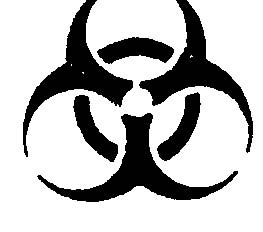1-9. HEALTH CARE WORKERS AT RISK
According to Occupational Safety and Health Administration (OSHA) estimates, approximately 5.6 million workers in health care and other facilities are at risk of exposure to bloodborne pathogens such as the human immunodeficiency virus (HIV), hepatitis B virus (HBV), and other potentially infectious materials (OPIM).
a. Those workers who have occupational exposure to bloodborne pathogens include, but are not limited to: nurses, physicians, dentists and dental workers, laboratory and blood bank technologists and technicians, medical examiners, morticians, phlebotomists, emergency room personnel, orderlies, housekeeping personnel, laundry workers, and military medics.
b. Others also at risk include law enforcement personnel, firefighters, paramedics, emergency medical technicians, and anyone else whose job might require providing first-response medical care in which there is a reasonable expectation of contact with blood or OPIM.
1-10. DEFINITIONS
a. Bloodborne Pathogens. Pathologic microorganisms that are present in human blood and can cause disease in humans. The term blood includes whole blood, blood components, and products made from human blood.
b. Body Fluids. Fluids that have been recognized by the Centers for Disease Control as directly linked to the transmission of HIV, HBV, and to which universal precautions apply are blood, semen, vaginal secretions, cerebrospinal fluid, synovial fluid, pericardial and amniotic fluids, and concentrated HIV or HBV viruses. Body fluids are also referred to as OPIM.
1-11. BLOODBORNE PATHOGENS: HUMAN IMMUNODEFICIENCY VIRUS AND HEPATITIS B VIRUS
a. Epidemiology.
(1) Approximately eight to ten million persons are thought to be infected with HIV world-wide. The incubation period is still unknown. Early symptoms are fatigue, low-grade fever, and general malaise.
(2) Less than five percent of the United States (US) population is reported to be HBV positive. The incubation period is usually 60–90 days with a range of 30–180 days; however, some cases have been reported ten years after initial exposure. HBV may be asymptomatic, detected through serologic tests. Early symptoms may be flu-like, nausea and vomiting, fatigue, and mild liver enlargement. Late symptoms include darkening urine, light-colored stool, jaundice, anorexia, and itching.
b. Transmission.
(1) For soldiers working in the health care environment, the most common means of exposure to bloodborne pathogens is through accidental needle-stick with contaminated blood or other body fluids.
(2) The second most common means of exposure in the workplace is contact by an open wound or non-intact skin (chapped or abraded skin) of a health care worker to contaminated blood, other body fluids, or concentrated virus.
(3) In the community, the most common means of transmission of HIV and HBV is through contaminated body fluids during sexual activity, especially semen and vaginal secretions.
c. Prevention.
(1) Universal precautions prevent health care workers from coming into contact with blood and other body fluids of patients. These precautions are methods of infection control in which all human blood and certain body fluids are treated as if known to be infectious for HIV, HBV, and other bloodborne pathogens. If there is any doubt, all body fluids are to be considered potentially infectious.
(2) There is a Hepatitis B vaccination available to all health care providers who have occupational exposure to bloodborne pathogens. Vaccinations consist of a series of three inoculations over a six-month period. The vaccine is safe and effective,and it protects for up to five to seven years after the first inoculation.
1-12. UNIVERSAL PRECAUTIONS
a. Work Practices Controls.
(1) All containers used as receptacles for regulated waste, contaminated sharps (objects that can penetrate the skin), contaminated laundry, or other containers used to store, transport, or ship blood or OPIM are labeled with the biohazard label (see figyre 1-6).

(2) Red bags or red rigid containers may be used as a substitute for the biohazard label when applicable.
(3) Needles must be disposed of into approved sharps containers without being broken or bent.
b. Personal Protective Equipment.
Known as PPE, this means specialized clothing or equipment worn for protection from exposure to blood or OPIM.
(1) Disposable gloves, gowns, masks, airway shields, etc.
(2) Biohazard bags.
(3) Disinfectant soap.
(4) Goggles, glasses, or face shields.
c. Exposure Occurrence.
(1) An exposure incident is specific eye, mouth, other mucous membrane, non-intact skin, or parenteral contact with blood or OPIM that results from the performance of soldiers’ duties.
(2) If such an incident occurs, follow the guidance of your local Exposure Control Plan. Your hospital or your unit will have such a plan. For more information about the OSHA plan, see OSHA Bloodborne Pathogens Exposure Control Plan.
